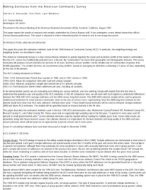Making Estimates from the American Community Survey
Making Estimates from the American Community Survey
Introduction and Background
This paper discusses the estimation methods used for the 1996 American Community Survey (ACS). In particular, the weighting strategy and weighting factors are described in detail.
The American Community Survey is a new Census Bureau initiative to update regularly the social and economic profile of the nation's communities that the U.S. census has traditionally produced once a decade. By "communities" we mean both geographic and demographic domains. The survey eventually will produce annual estimates for domains of all sizes, but these annual "profiles" will be reliable only for communities of greater than 65,000 population. For smaller domains, we recommend using "profiles" based on averaging (or otherwise cumulating) 2-5 years of data, depending on the size of the domain.
The ACS is being introduced as follows:
1996-1998 Demonstration Period (four counties in 1996, nine in 1997, eleven in 1998)
1999-2001 About 40 comparison sites with 5 percent annual samples
2000-2002 National comparison sample with overall rate of 0.7 percent annually
2003-on Full introduction (three million addresses per year, including all counties).
In the demonstration period, we are evaluating and refining our survey methods, and also working closely with experts from the test sites to understand the potential uses and quality of the ACS estimates. In the 40 comparison sites, we will work with local experts to understand differences between the 1999-2001 ACS average estimates and the 2000 census long form results. The 2000-2002 national sample will be used to generate model-based estimates for small domains nationwide--down to the size of census tracts--representing "what the 2000 long-form estimate for the domain would have been had ACS data collection methods been used." These model-based estimates will be used to interpret changes between 2000 and future ACS estimates. The models will be specified based on lessons learned in the 40 sites.
This paper describes the estimation methods used in the four 1996 ACS demonstration sites: Multnomah County/Portland OR, Rockland County NY, Brevard County FL, and Fulton County PA. These areas had an especially high sampling rate in the first year, 15 percent in most areas and 30 percent in small governmental units,2 so that detailed estimates could be studied without waiting for multiple years' data. Some initial results are presented, along with future research issues. Our ultimate interest is in implications for the best methods and likely quality of the 2003 and later annual estimates which will be based on an approximate 3 percent annual rate in most areas.
Issues of cumulating multiyear data have been discussed at length in Alexander (1996).
Others in Series
Working Paper
Working Paper
Working Paper




